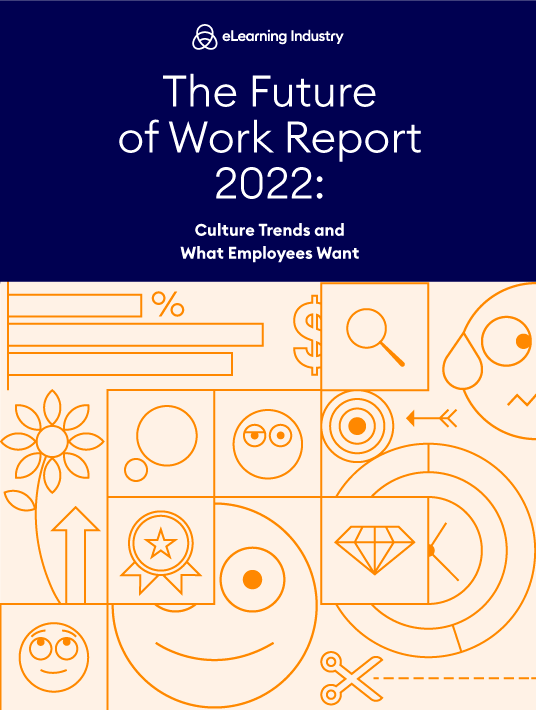Corporate Culture Trends To Keep An Eye On For 2023
Believe it or not, some organizations emphasize the importance of building an efficient corporate culture. You see, a good company culture will not only make a company stand out from others, but it has the power to give your business a competitive edge, as well. To help the business world and its leaders, we've decided to run a survey and see what employees want, and if there are any corporate culture trends you can leverage. The insights we got were astounding. Do you want to get the full scoop? Feel free to download the Future of Work report! You'll better understand what you're doing wrong in your organization and what you could do to fix it.
Of course, every organization has its own corporate culture. Here at eLearning Industry, we use culture as our pillar. Our company culture is what defines who we are as a business. eLearning Industry's culture comprises our organization's beliefs and core company values. And mind you, we're very proud of what we have accomplished. We've even been named a best workplace in Greece for it. Long gone are the days when top talent was looking for just a job. The best employees in the market want to work for a company that matters, for a company that cares about making a difference in the world. Thus, you must indulge everyone from top to middle management when planning out your company culture. Doing so will help you get everyone's perspective and help you devise a culture that fits what employees want.
Buckle up as this article discusses the corporate culture trends that will help you in 2023.

Which Corporate Culture Trends Are Shaping The Future Of Work?
COVID-19 has undoubtedly transformed the very nature of the employer-employee dynamic. In the post-pandemic world, a few new trends have come into play. These trends have made us question company culture and how we can improve things for employees. Many leaders took for granted how the workplace functioned before the pandemic. The same goes for what was expected from management and the employees. For example, before the pandemic, employees had to work on-site. But hybrid work has now taken a stronghold, shifting things to other, flexible solutions.
That said, employees are fundamentally reconsidering what they want. Not only when it comes to their careers but also regarding the way they want to work. We've all heard of the Great Resignation, where millions quit their jobs. That has to mean something. Thankfully, there are employers who want to support the needs of a diverse workforce. And many are ready to shift things up by following the new corporate culture trends that have risen.
To help leaders manage hybrid work transition and the return to the workplace, we've identified some trends through our recent survey on the future of work. Companies can use these insights to reimagine and reinvent how work gets done post pandemic. Employers must take note of these corporate culture trends as they start planning their future work models.
1. Benefits That Matter
Every company culture includes employee benefits. But how effective and meaningful are they? It depends on you as a manager and a leader to figure out what employees want and how to improve employee retention and satisfaction with what you offer. Thus, companies need to plan out the right benefits package. Doing so will help you increase engagement and productivity. And with the rise of millennials and Gen Z in the workplace, you've got a few extra things to consider. As mentioned above, flexibility is key. Please consider that your benefits package should help employees grow their careers and personal lives.
49% say leaders have created benefits/perks that aren't competitive or exciting. So, clearly, there's a disconnect here.
Nearly half (45%) would prefer to have more vacation time than "company culture." The top two aspects deemed most important to company culture—flexibility (32%) and good pay, benefits, and bonuses (29%)—have nothing to do with "traditional views of company culture" like getting together, working in an office, and team building.
One thing is clear: leaders need to make perks a bigger part of company culture. Though culture still matters to more than half of workers, it is clear there's a shift happening. Hybrid work, robust benefits, and opportunities for career growth and continuous learning are more essential perks than a ping-pong table in the office or team-building activities. Employers should invest in perks and recognize this is the new normal.
So, for 2023, make sure to focus more on providing the benefits that matter. We've all been through enough hardship during the last few years. It's time to get our lives back. Now's the time to give employees what they deserve for their hard work.
2. Flex Schedules
Employers should note that four in every five of their employees could be more easily swayed to jump ship by a favorable hybrid work environment or salary than strong team culture. They should also note that this is probably the new normal: 67% believe company culture is less about "team building" and more about offering employees benefits and flexible work options.
Look, hectic schedules lead to unproductive teams and employees getting high burnout. Hence, companies have to realize that employees need some time off. When leaders empower team members to have a schedule that allows flexibility in their work, productivity will rise. With flexible schedules in the organization, your employees can deliver on schedule and maintain their work-life balance. If you feel like challenging the status quo, then flex schedules are something you should consider.
If we've understood one thing during the pandemic, it's that taking time off for family and friends is so important to have a good personal life. And when personal life goes well, that reflects on the business because employees don't dread working on their projects. When you allow employees to have a flexible schedule, you'll observe employee job satisfaction levels improving. And, of course, that will lead to higher employee retention and a reduction in turnover rates. Not to mention that having happy employees drives better customer experiences and satisfaction.
Let's be honest: we'll never return to a 9–5 work day at the office, five days a week. The sooner leadership recognizes this fact, the better. Employees are happier and more productive when they can create their work environment instead of having one created for them. In addition, hiring people and empowering them to work wherever creates a better, more diverse workplace.
3. Equality In The Workplace
There's no question that companies need to foster diversity and treat everyone equally. 43% of employees believe their company's culture is outdated because the current leadership is older and/or not diverse.
And a stunning 34% call the culture "toxic" due to a lack of diversity, equity, and inclusion (DEI) initiatives that leave employees feeling they cannot be authentic at work.
Unfortunately, the lack of diversity is substantial: 41% say the company is not diverse and doesn't prioritize diversity, while 30% say leadership is prejudiced against women and certain minorities.
And we all know that an organization lacking diversity and equal opportunity will not be successful. Leadership must adopt organizational commitment from the top down to foster diversity. Not just racial and ethnic diversity, but the diversity of thought as well. Leaders also need to ensure they are empowering all employees equally; no person should feel they've been passed over for a promotion because their boss and co-worker are friends.
Favoritism has hit the roof, as 76% say leaders show bias toward certain people. Also, 60% say management only promotes people who share the same opinions as they do. The latter reached 69% of tech workers. Shockingly, 78% of manufacturing and 75% of retail and hospitality workers say their leaders show favoritism.
When all these insights come amid the ongoing Great Resignation and the trend of "quiet quitting," disenchanted and disengaged employees are looking for greener pastures.
At least, it's promising that 61% of employees believe remote and virtual environments will increase their company's diversity and inclusion.
If you're interested in DEI initiatives. make sure to check some of the best diversity and inclusion training programs.
4. Mindfulness And Psychological Safety
Two in five (40%) don't believe leaders care about or have prioritized support for employee mental health and well-being.
Mindfulness is about not being judgemental and living in the moment. It is a healthy practice that not only helps reduce stress in the workplace, but it can also lead employees to be more productive. Mindfulness is an approach that helps accept and understand one's feelings and thoughts. Practicing this kind of leadership can certainly improve the way management connects with employees, and it can foster better relationships and communication.
This is one of our favorite corporate culture trends to consider while entering the new year. For example, you can offer leaders and employees meditation programs and wellness apps to help them practice mindfulness in the workplace. It's a great way to help everyone destress by creating positive psychological energy in the workplace. And we all know how crucial psychological safety is for organizations. It actually results in building a high-performance culture. What we love about it is that it fosters innovation. That way, employees become open to ideas. Plus, psychological safety makes it easier to promote team collaboration and improve productivity.
You should try this healthy practice to encourage everyone in your company to be transparent and foster a positive mindset.
5. Employee Experience
Owning a business sometimes is more than just gaining profits and revenue. Taking care of your employees is key if you want your organization to thrive. After all, your employees are your most valuable assets. Don't take the employee experience lightly. How employees experience your company while working for your organization will undoubtedly reflect their daily work.
That's why leaders and businesses should care about the employee experience they offer. There are many best practices your organization can follow to create an amazing employee experience. However, it all comes down to what ways leaders choose to provide for their employees. Remember that a good employee experience positively impacts the levels of employee engagement and how they deliver their work.
Employee experience is a critical factor to your business's success because it makes or breaks employee satisfaction and how much they want to offer when working for you every day.
Unfortunately, more than a third (37%) of employees believe culture doesn't exist in the workplace today. With this post-pandemic revelation, it's evident that a disconnect has emerged in the leader-employee relationship: 50% of all workers say their leaders don't understand what constitutes a strong company culture or what employees want.
Beyond Learning and Development programs, employees also crave more support in creating environments conducive to their work style. Two in five (44%) say leaders need to be more in touch regarding how they prefer to work because they want employees working in the office versus at home. It's clear that in the future, as technology evolves, instead of completing activities in person, employees would consider completing work activities in a virtual environment, such as the metaverse or another form of Virtual Reality or 3D environments.
6. Focus More On Employee Development
As more and more millennials and Gen Zers join the workforce, providing classic benefits is not always enough. These generations are the future of your organization, and if you want to keep employee satisfaction high, then you need to think out of the box.
Such young, energetic, and innovative individuals are always on the lookout to develop their skills every day. Hence, it would be wise for company leadership to provide employees with the right tools for professional development and growth.
Sadly, most companies don't offer Learning and Development opportunities. More than half of workers say their organization doesn't offer learning or development programs to help workers grow and get promoted. Notably, 60% of retail and hospitality workers say the same.
80% would complete training or learning programs with virtual teachers or simulations. And 84% would attend meetings in virtual conference rooms.
It's evident that love for learning certainly motivates, increases employee satisfaction, and leads to company growth.
Leaders must provide the right growth opportunities for employees. By investing in proper employee training programs, you can increase the satisfaction levels of your employees. And this will lead to increased employee loyalty and, of course, higher retention rates. In the end, you only have to win.
Hence, by offering employee development opportunities, you can improve your bottom line and set a perfect example of an ethical culture that gives room for employees to grow.
7. Prioritizing Employee Engagement
Have you ever considered that your employees can help you change the workplace and improve it for the better? Unfortunately, nearly half of employees (48%) say they have either not been asked for their input or had their input considered by leadership in culture-related matters. This disconnect makes employees feel disengaged and threatens to impact employee retention significantly, with 46% saying leadership decisions on culture have led them to consider finding new employment.
If your teams need a proactive hybrid work strategy, maybe you should rethink your steps in the years to follow. Some of them might want to improve their skills and grow within the business. Don't deprive them of an opportunity to grow. By enabling flexibility and growth opportunities for employees, you have a lot to gain. First off, you'll manage to strengthen employee engagement and enhance productivity.
Leaders must amplify the voices of employees. Always be honest with your employees and let them know what's happening. Honesty and transparency are the bare minimum to value integrity and increase trust. Also, listen to what your team has to say. The people who work for you are the core of your business. Everything happens because of them. That's why it's essential to take notice of their thoughts, feelings, and feedback. Don't just hear what employees want, but act upon it.
Encouraging your team to speak up about what matters to them and what needs to be addressed is key for a successful business.
Key Takeaway
Employees and management teams must agree when aiming for a thriving culture. By following the company culture trends in this article, you'll be able to synchronize how your organizational culture works. That way, you can build a culture that works for everyone without any setbacks.
Let this be the start of creating a company culture that focuses on what employees want. Your teams will enjoy being a part of a workplace where collaboration and learning are a top priority. Along with focusing on employees' well-being, you can do miracles for your business. Just show your teams how much you value their work and that you are happy to invest in them.
You have so much to gain for years to come. Because employees make or break business success.
Show your employees they matter!
Get full-on insights by downloading the Future of Work survey.









